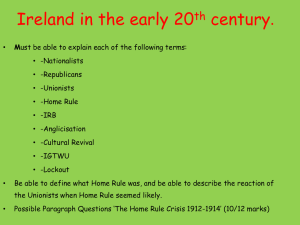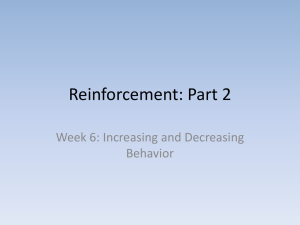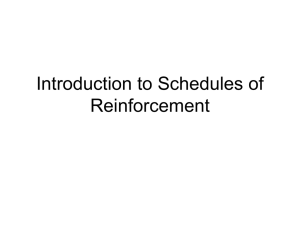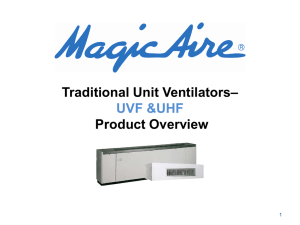NCDOT*s Experience Using Ultraviolet - Trb
advertisement
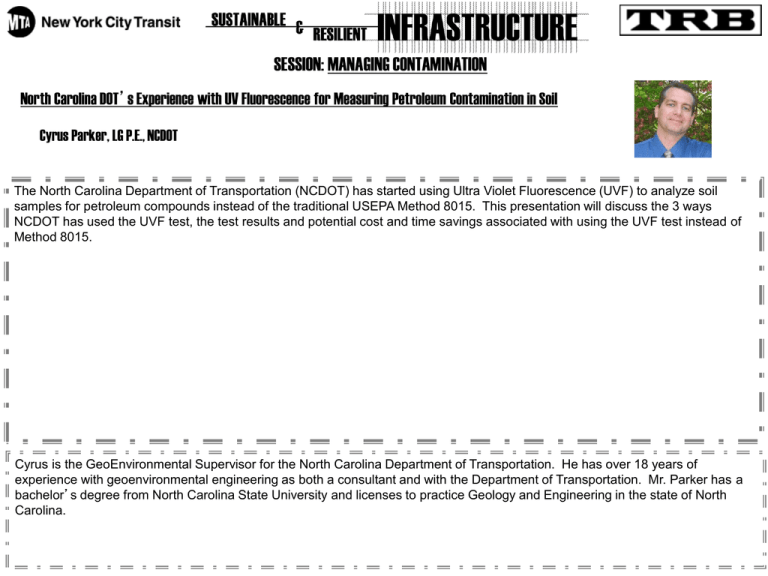
SESSION: MANAGING CONTAMINATION North Carolina DOT’s Experience with UV Fluorescence for Measuring Petroleum Contamination in Soil Cyrus Parker, LG P.E., NCDOT The North Carolina Department of Transportation (NCDOT) has started using Ultra Violet Fluorescence (UVF) to analyze soil samples for petroleum compounds instead of the traditional USEPA Method 8015. This presentation will discuss the 3 ways NCDOT has used the UVF test, the test results and potential cost and time savings associated with using the UVF test instead of Method 8015. Cyrus is the GeoEnvironmental Supervisor for the North Carolina Department of Transportation. He has over 18 years of experience with geoenvironmental engineering as both a consultant and with the Department of Transportation. Mr. Parker has a bachelor’s degree from North Carolina State University and licenses to practice Geology and Engineering in the state of North Carolina. Ultra Violet Fluorescence Soil Analysis Cyrus Parker, LG, PE North Carolina Department of Transportation The Green Box Overview Ultra Violet Fluorescence (UVF) • • • • Introduction to UVF Data Comparison with EPA Method 8015 User Feedback Cost Comparison with EPA Method 8015 Weigh 10 Grams Soil Add Methanol to soil. Shake. Wait. Extract Sample and Transfer to Cuvette Place Cuvette into analyzer, Enter Sample ID and Click Analyze Diesel Fuel Heavy Fuel Oil Regulatory Approval Suspected Contaminant 1a. Low Boiling Point Fuels: gasoline, aviation gasoline, etc. a 1b. Ethanol-Gasoline Blends 2. Medium/High Boiling Point Fuels: jet fuels, kerosene, diesel, fuel oil #2, biodiesel (containing diesel), etc. Varsol, mineral spirits, naphtha. 3. Heavy Fuels: #4, #5, #6 fuel oils, motor oil, hydraulic fluid, etc. Mineral oilc 4. Used / Waste Oil Analytical Methods for Preliminary Investigation Samples EPA 8015C for TPH-GRO (or UVF for TPH)b EPA 8015C for TPH-GRO (or UVF for TPH)b and EPA 8260B EPA 8015C for TPH-GRO and EPA 8015C for TPHDRO (or UVF for TPH)b Analytical Methods for Samples Collected after Preliminary Investigation EPA 8260B and MADEP VPH EPA 8015C for TPH-DRO (or UVF for TPH)b EPA 8270D and MADEP EPH EPA 8260B, EPA 8270D, MADEP VPH, MADEP EPH, (or UVF for TPH and PAH)b and EPA 3050B or 3051A Prep: Total Metals (Cr and Pb), EPA 8081B (pesticides),and EPA 8082A (PCBs)d EPA 8260B, EPA 8270D, MADEP VPH, MADEP EPH, EPA 3050B or 3051A Prep: Total Metals (Cr and Pb), EPA 8081B (pesticides), and EPA 8082A (PCBs)e EPA 8260B, EPA 8270D, MADEP VPH, and MADEP EPH Key Notes: UVF and EPA Method 8015 Data Comparision NOTE: This summary represents a review of soil samples collected as grab samples on-site, analyzed immediately in the field, followed by submitting a separate container to the laboratory for 8015 analysis. Some samples noted were submitted for UVF testing for 24 or 48 hour TAT. Thorough Homogenization was not applied. It is important to note that the Lab and the UVF did not test the same 10g sample or extract in this correlation study. 1400 Lincoln DRO Samples 1200 D 1000 R O ( m g / k g 800 QED/DRO 8015/DRO 600 ) 400 200 0 0 2 4 6 Sample Number 8 10 1) HA-1 2) HA-2 3) HA-3 4) HA-4 5) HA-5 6) HA-7 7) HA-8 8) HA-9 UVF/DRO 503 68.1 1322 0 2.4 2.5 3.3 3.8 8015/DRO 264 46.2 1060 0 0 0 0 0 •In the last 4 samples the Lab results a Non Detect and the UVF results in below the action limit. The UVF results show that there are still trace amounts in the sample. Note the fingerprint example on next slide. •ONSITE RENTAL UVF Fingerprint Sample HA-5 (F&R, Lincoln) 5) HA-5 UVF/DRO 2.4 8015/DRO 0 UVF fingerprint trace clearly shows the presence of a degraded petroleum hydrocarbon. This is consistent with all samples where the Lab reports 0… 5000 1) 4-1 2) 4-3 3) SB-1 4) SB-2 5) SB-7 Rowan DRO Samples 4500 4000 3500 D R O 3000 ( m 2500 g / 2000 k g 1500 QED/DRO 8015/DRO ) 1000 UVF/DRO 40.5 13.8 3504.6 2356 579.2 8015/DRO 123 6.6 3440 3220 528 • Values are very close for the DRO range. • A 30% error bar is incorporated into this graph to show that the UVF/8015 values fall within the 30% error range. 500 • OFFSITE UVF LAB 0 0 1 2 3 4 Sample Number 5 6 6000 Rowan GRO Samples 5360 5170 4-1 4-3 SB-1 SB-2 SB-7 5230 5000 G 4000 R O • QED/GRO 8015/GRO ) 1000 844.7 6.9 0 1 293.4 0 4.6 0 989.9 0 2 3 4 Sample Number 5 6 8015/GRO 6.9 0 5170 5230 5360 • Highlighted numbers are very close to standard calibrator values for GC 8015. All other samples correlated • OFFSITE LAB ( m 3000 g / k g 2000 UVF/GRO 4.6 0 844.7 989.9 293.4 SB-1 Lab Result UVF/GRO SB-1 844.7 8015/GRO 5170 SB-2 Lab Result UVF/GRO SB-2 989.9 8015/GRO 5230 SB-7 Lab Result UVF/GRO SB-7 293.4 8015/GRO 5360 Background Organics SB-1 SB-2 SB-3 SB-4 UVF/GRO 844.7 989.9 0 0 UVF/DRO 3504 2356 0 0 *The top 2 fingerprints represent the presence of the contaminant in high concentrations. *The bottom 2 fingerprints represent how a negative on the Rowan site would appear with background organics. *Please note the dates in which the samples where collected and the dates in which they were analyzed at the lab. UVF sample data was generated within 24 hours. The UVF fingerprints exhibit the high levels of background organics in the samples, which may account for the high recoveries and results in the lab data. The Matrix Spike and Matrix Spike Duplicate for these samples show 133% and 155% surrogate recovery. They have a qualifier to that effect In the QA/QC data. 35000 Guilford DRO Samples UVF/DRO 8015/DRO 110-3-10 12.9 <7.0 137-7-2 2.1 22.9 155-4-10 30.6 308 66-6-10 31283 26600 137-8-15 31283 30000 26600 66-14-8 190 252 66-19-9 915.3 5460 25000 66-25-12.5 4515.8 4580 D R O 20000 66-26-11 7184 0 116-16-10 21.5 148 116-16-12 13.7 17 ( QED/DRO m g / 15000 k g 8015/DRO ) 10000 5460 5000 0 0 0.00 22.9 12.9 2.1 2 308 252 30.6 4 190 7184 4580 4515.8 915.3 0 6 8 Sample Number 148 17 21.5 13.7 10 12 *Sample 66-26-11 is a major discrepancy. A review of S&ME field notes indicated a positive PID reading, odor and discoloration for this sample. 400 Guilford GRO Samples 380 360 340 320 300 280 G R 260 O 240 220 ( m g / k g 200 UVF/GRO 180 176.2 8015/GRO 160 140 ) 120 100 83.1 63.8 60 40.1 54 40 12.9 20 0 0 0 0 0 0 2 7.9 0 0 7.6 3.7 4.2 4 6 8 Sample Number 25.4 0 8015/GRO 0 12.9 <7.2 0 696 7.9 <6.7 40.1 0 63.8 120 Sample fingerprints on the following slides exhibit background organics and explanation of conflicts. 120 80 110-3-10 137-7-2 137-8-15 155-4-10 66-6-10 66-14-8 66-19-9 25-12.5 26-11 116-16-10 116-16-12 UVF/GRO 0 0 3.7 4.2 2432 7.6 83.1 176.2 54 25.4 8.8 8.8 10 12 • ONSITE LAB UVF/DRO 8015/DRO 137-7-2 2.1 22.9 66-6-10 31283 26600 110-3-10 12.9 <7.0 137-7-2 Exhibits background organics substantial in the low level sample. 66-6-10 Exhibits an over range sample that was not diluted or recalculated with the UVF and may have been closer to Lab result. 110-3-10 Lab reports <7.0 mg/kg for DRO, UVF reports 12.9 mg/kg DRO. Product is present in sample. UVF/ DRO 8015/ DRO 137-8-15 <1.3 <6.1 66-19-9 915.3 5460 UVF/ GRO 3.7 83.1 8015/ GRO <7.2 <6.7 137-8-15 Normal blank subtraction was not carried out in this sample. UVF reported 3.7 mg/kg GRO and the Lab reported <7.2 mg/kg GRO. 66-19-9 High concentrations of degraded diesel would require a large dilution by GC for the DRO range and it is possible the GRO range was diluted away in the process. Lab reports 5,460 mg/kg DRO and < 6.7 GRO respectively. This product is NOT highly degraded, thus to produce such high levels of DRO and NO GRO would be atypical for Diesel fuel. *PLEASE NOTE background and particulate present in the samples from this site. 600 Pitt DRO Samples 101_SS1 96_SS-7 071_2-2 075_3 079-1 085_1 500 D 400 R O 391 ( m 300 g / k g 200 QED/DRO 8015/DRO ) 100 37.3 4.8 19.6 0 0 1 2 15.3 12.1 17.1 0 3 4 Sample Number 4.8 1.9 0 5 0 6 7 UVF/DRO 8015/DRO 4.8 37.3 15.3 12.1 4.8 1.9 19.6 391 17.1 0 0 0 • The Fingerprints clearly show the presence of petroleum product. 1 Pitt GRO Samples UVF/GRO 8015/GRO 0 0 <0.6 <07 <0.6 <0.6 0 0 0 0 0 0 101_SS1 96_SS-7 071_2-2 075_3 079-1 085_1 0.9 0.8 0.7 G R O 0.6 ( m 0.5 g / 0.4 k g 0.3 QED/GRO 8015/GRO ) 0.2 0.1 0 0 0 0 0 0 0 2 0 0 0 4 Sample Number 0 0 0 0 6 8 • 100% Correlation 071_2-2 075_3 UVF/DRO 15.3 12.1 8015/DRO 17.1 0 71-2(0-2) Lab reports 17.1 mg/kg DRO and UVF reports 15.3 mg/kg DRO, which shows almost a perfect correlation. 75-3(0-2) Lab reports 0 mg/kg for DRO and UVF reports 12.1 mg/kg DRO. A very clear fluorescent fingerprint of fuel product. 079-1 085_1 UVF/DRO 4.8 1.9 8015/DRO 0 0 79-1(0-2) Lab reports 0 mg/kg DRO and the UVF reports 4.8 mg/kg DRO. A very clear fingerprint of fuel product is shown in the fingerprint. Perhaps it was detected below the lab PQL? 85-1(0-2) Lab reports 0 mg/kg DRO and UVF reports 1.9 mg/kg. Perhaps it was detected below the lab PQL? 96_SS-7 UVF/DRO 37.3 8015/DRO 391 Batch SS-7 QC Data SS-7 Chromatogram 96_SS-7 UVF/DRO 37.3 8015/DRO 391 User Feedback Overall experience using rapid UVF analysis. 9 8 8 7 7 6 5 4 3 2 1 1 0 0 0 Extremely poor Poor Satisfactory Good Excellent Would you recommend replacing traditional TPH/GRO/DRO chemistry with rapid UVF analysis for soil site assessments? No Yes Are You Confident in Rapid UVF Analysis? No 33% Yes 67% Cost Analysis UVF Options • Onsite UVF Equipment Rental for Immediate Results • ~$800 per day • • • • • Rental Shipping Supplies Additional Labor Onsite Laboratory for Immediate Results • ~$1100 per day (all inclusive) • Ship to Offsite Laboratory for 24 or 48 hour Results • 24 hour $55 per sample • 48 hour $45 per sample Method 8015 vs UVF Cost Analysis $100,000.00 $90,000.00 $80,000.00 $70,000.00 $60,000.00 $50,000.00 Laboratory Cost $40,000.00 $30,000.00 $20,000.00 $10,000.00 $Actual 8015 2 week Turnaround Price if UVF 48 HR Turnaround 8015 vs UVF Cost Analysis $350,000.00 $314,874.00 $300,000.00 $250,000.00 $200,000.00 Laboratory Cost $150,000.00 $100,000.00 $51,682.50 $50,000.00 $Price if 8015 48 HR Turnaround Price if UVF 48 HR Turnaround The Real Question Would the regulatory decision change if UVF was used instead of Method 8015? Change recommendations as a result of using UVF for GRO samples? Yes 10% No 90% Change recommendations as a result of using UVF for DRO samples? Yes 20% No 80% Change Site Recommendation as a result of using UVF Based on 49 sites Yes 16% No 84% Conclusions • • • • • Flexibility for onsite or laboratory analysis Potential cost and time savings Experienced users like the system Less Experienced users can ship samples to laboratory for analysis similar to their current process Using UVF would not have change our recommendations, most of the time More Information? Felecia Owen QROS, LLC fowen@qros.us 919-278-8926 http://qros.us/ Cyrus Parker NCDOT cfparker@ncdot.gov 919-707-6868
